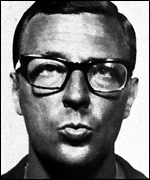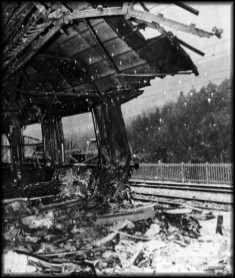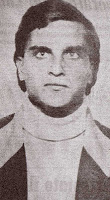
Francesco Maurizio Cossiga was an Italian politician. A member of Christian Democracy, he was prime minister of Italy from 1979 to 1980 and the president of Italy from 1985 to 1992. Cossiga is widely considered one of the most prominent and influential politicians of the First Italian Republic.

Giulio Andreotti was an Italian politician and statesman who served as the 41st prime minister of Italy in seven governments, and was leader of the Christian Democracy party and its right-wing; he was the sixth-longest-serving prime minister since the Italian unification and the second-longest-serving post-war prime minister. Andreotti is widely considered the most powerful and prominent politician of the First Republic.

The Piazza Fontana bombing was a terrorist attack that occurred on 12 December 1969 when a bomb exploded at the headquarters of Banca Nazionale dell'Agricoltura in Piazza Fontana in Milan, Italy, killing 17 people and wounding 88. The same afternoon, another bomb exploded in a bank in Rome, and another was found unexploded in the Tomb of the Unknown Soldier. The attack was carried out by the far-right, neo-fascist paramilitary terrorist group Ordine Nuovo and possibly certain undetermined collaborators.

Stefano Delle Chiaie was an Italian neo-fascist terrorist. He was the founder of Avanguardia Nazionale, a member of Ordine Nuovo, and founder of Lega nazionalpopolare. He went on to become a wanted man worldwide, suspected of involvement in Italy's strategy of tension, but was acquitted. He was a friend of Licio Gelli, grandmaster of P2 masonic lodge. He was suspected of involvement in South America's Operation Condor, but was acquitted. He was known by his nickname "il caccola" as he was just over five feet tall - although he stated that originally, the nickname came from his very young involvement, at age 14, in the Italian Social Movement (MSI), a neo-fascist political party established after the war

The Bologna massacre was a terrorist bombing of the Bologna Centrale railway station in Bologna, Italy, on the morning of 2 August 1980, which killed 85 people and wounded over 200. Several members of the neo-fascist terrorist organization Nuclei Armati Rivoluzionari were sentenced for the bombing, although the group denied involvement.
Vincenzo Vinciguerra is an Italian neo-fascist activist, a former member of the Avanguardia Nazionale and Ordine Nuovo. He is currently serving a life-sentence for the murder of three Carabinieri by a car bomb in Peteano in 1972. The investigation in this previously unsolved affair by prosecutor Felice Casson led to the revelation of "Gladio" networks around Western Europe.

Right-wing terrorism, hard right terrorism, extreme right terrorism or far-right terrorism is terrorism that is motivated by a variety of different right-wing and far-right ideologies. It can be motivated by Ultranationalism, neo-Nazism, anti-communism, neo-fascism, ecofascism, ethnonationalism, religious nationalism, anti-immigration, anti-semitism, anti-government sentiment, patriot movements, sovereign citizen beliefs, and occasionally, it can be motivated by opposition to abortion, tax resistance, and homophobia. Modern right-wing terrorism largely emerged in Western Europe in the 1970s, and after the Revolutions of 1989 and the dissolution of the Soviet Union in 1991, it emerged in Eastern Europe and Russia.
The Banda della Magliana was an Italian criminal organization based in Rome. It was founded in 1975. Given by the media, the name refers to the original neighborhood, the Magliana, of some of its members. It is considered the most powerful and violent criminal organization ever to operate in Rome.

The Nuclei Armati Rivoluzionari, abbreviated NAR, was an Italian terrorist neo-fascist militant organization active during the Years of Lead from 1977 to November 1981. It committed over 100 murders in four years, and had planned to assassinate the politicians Francesco Cossiga, Gianfranco Fini and Adolfo Urso. The group maintained close links with the Banda della Magliana, a Rome-based criminal organization, which provided such logistical support as lodging, false papers, weapons, and bombs to the NAR. In November 1981, it was discovered that the NAR hid weapons in the basements of the Health Ministry. The first trial against them sentenced 53 people in May 1985 on charges of terrorist activities.

Carmine "Mino" Pecorelli was an Italian journalist, shot dead in Rome a year after former prime minister Aldo Moro's 1978 kidnapping and subsequent killing. He was described as a "maverick journalist with excellent secret service contacts". According to Pecorelli, Aldo Moro's kidnapping had been organized by a "lucid superpower" and was inspired by the "logic of Yalta". Pecorelli's name was on Licio Gelli's list of Propaganda Due masonic members, discovered in 1980 by the Italian police.

In Italy, the phrase Years of Lead refers to a period of political violence and social upheaval that lasted from the late 1960s until the late 1980s, marked by a wave of both far-left and far-right incidents of political terrorism and violent clashes.
Mario Amato was an Italian magistrate, assassinated in 1980 by NAR members Gilberto Cavallini and Luigi Ciavardini.

The Train 904 bombing was a terror attack which occurred on 23 December 1984, in the Apennine Base Tunnel. A bomb on the 904 express train from Naples to Milan was detonated, killing 16 and wounding 266. The bombing location was near the location of the Italicus Express bombing ten years previously.
The Acca Larentia killings, also known in Italy as the Acca Larentia massacre, were a double homicide that occurred in Rome on 7 January 1978. The attack was claimed by the self-described Nuclei Armati per il Contropotere Territoriale. Members of militant far-left groups were charged but acquitted, and the culprits were never identified.
Massimo Carminati, referred by the press as one of "the kings of Rome", in the context of the onset of the "Mafia Capitale" investigations among 3 other bosses, nicknamed as "il Cecato", is an Italian underworld figure and former member of far-right terrorist group Nuclei Armati Rivoluzionari and criminal gang Banda della Magliana, which were at the centre of sensational allegations of state collusion and Masonic conspiracy during Italy's Years of Lead. Carminati was investigated for match fixing in 2012. In 2014 he was arrested with 36 others on allegations of running a corrupt network that infiltrated Rome's public administration. He was charged with fraud, money laundering, embezzlement, and the bribing of public officials. In 2017, Carminati was sentenced to 20 years in jail. The sentence was revoked in 2018 and he is free since 2020.

Terrorism in Italy is related to political and subversive terrorism activities, carried out by various groups and organizations with different and sometimes conflicting methods, motivations and interests. This article is primarily about late 20th-century and early 21st-century terrorism.

Francesca Mambro is an Italian activist and former terrorist, who was a leading member of the far-right Italian Armed Revolutionary Nuclei (NAR). She was arrested in Rome in March 1982 for complicity in the Bologna bombing of August 1980. Mambro was tried and found guilty of 96 murders, for which she received a total of nine life sentences equating to over 84 years' imprisonment. Mambro was paroled in 2013 and her sentence expired five years later.

Franco Anselmi was an Italian neofascist terrorist who was active in the organization Nuclei Armati Rivoluzionari. He was killed during an attempt to rob a gun shop in Rome.
Alessandro Alibrandi was an Italian neofascist terrorist who was active in the organization Nuclei Armati Rivoluzionari. He was killed during a firefight with the police in Rome while attempting to steal their weapons.
Paolo Signorelli was an Italian author, activist, and politician of the extreme right.













